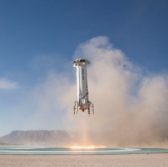 NASA will immerse 15 new potential space technologies in low-gravity simulating experiments using commercial aircraft, high-altitude balloons and suborbital rockets as part of the Flight Opportunities program.
NASA will immerse 15 new potential space technologies in low-gravity simulating experiments using commercial aircraft, high-altitude balloons and suborbital rockets as part of the Flight Opportunities program.
The space agency said Wednesday the effort will help mature the selected technologies for future space operations.
NASA Administrator Jim Bridenstine noted that the organization will work to financially support more payload flights in the future.
“By increasing funding for payload integration and flights, we will continue to support and advance the commercial suborbital flight market,†he noted.
The selected projects and principal investigators are as follows:
- “3D Printing of Hierarchical Foams in Microgravity,” led by Konstantinos Sierros of West Virginia University
- “Adapting the Ring-Sheared Drop Technology as a Bioreactor,” led by Amir Hirsa of Rensselaer Polytechnic Institute
- “Automated Radiation Measurements for Aerospace Safety,” led by W. Kent Tobiska of Space Environment Technologies
- “Dust In-situ Manipulation System,” led by Julie Brisset of University of Central Florida
- “Evaluation of Preserved Blood for Transfusion Therapy in Reduced Gravity,” led by Michael Menze of University of Louisville
- “Electrowetting Enhanced Dropwise Condensation in the Zero-g Environment,” led by Chung-Lung Chen of University of Missouri
- “Flight Test of a Balloon-borne Aeroseismometer,” led by Daniel Bowman
- “Integrated Remote Imaging System External Environment Remote Sensing from Suborbital Reusable Launch Vehicles,” led by Charles Hibbitts of Johns Hopkins University
- “Magneto-Active Slosh Control System for Spacecraft and Launch Vehicle,” led by Kevin Crosby, principal investigator of
- “Microgravity Investigation for Thin Film Hydroponics,” led by Christine Escobar
- “Spaceflight Testing of Film Evaporation MEMS Tunable Array Micropropulsion System for Interplanetary SmallSat,” led by Alina Alexeenko of Purdue University
- “Technology Demonstration of the Kentucky Re-entry Universal Payload System Capsule for Heatshield Validation,” led by Alexandre Martin
- “Using Single Event Effects to Generate Truly Random Numbers for Encryption Keys,” led by Brock LaMeres
- “Zero-g Slosh Model Technology: Knowledge Payload,” led by Steven Collicott of Purdue University
- “Transport Properties of Fluids for Exploration,” led by Richard Banish
NASA chose the projects through the Space Technology Research, Development, Demonstration, and Infusion Flight Opportunities solicitation that was issued March 30.




